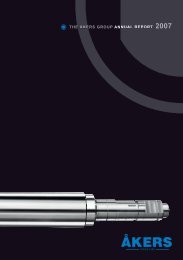CAEF Roll failures manual - The Åkers Group
CAEF Roll failures manual - The Åkers Group
CAEF Roll failures manual - The Åkers Group
You also want an ePaper? Increase the reach of your titles
YUMPU automatically turns print PDFs into web optimized ePapers that Google loves.
1.2.2 Origin<br />
High local loads at leading edges, cobbles or<br />
doubling of the strip end (tail end pinching),<br />
exceed the shear strength of the shell material<br />
and initiate the crack. Subsequent rolling<br />
fatigues the material and the crack propagates<br />
until a massive spontaneous spall occurs.<br />
Worn profiles on both work rolls and back up<br />
rolls through long campaigns give localised<br />
overloading, as do incorrect CVC profiles.<br />
<strong>The</strong> continued use of roll bending, back up<br />
rolls without barrel end relief, mill accidents<br />
and rolling foreign bodies will all contribute to<br />
the formation of the initial crack.<br />
This is a mill fault.<br />
1.2.3 Remedy<br />
Initial Microcracks<br />
Propagation in the Hardened Area<br />
Circumferential Fatigue Path<br />
Regular crack detection (ultrasonic, eddy current, dye penetrant) after each roll change will identify dangerous<br />
cracks and avoid major <strong>failures</strong> if such cracks are completely removed prior to the next campaign. Immediate roll<br />
change is strongly recommended after a severe mill incident with subsequent 100% crack detection and appropriate<br />
roll dressing before the next campaign. Additional measures such as controlled campaign length, adequate stock<br />
removal, correct roll camber, prevention of cobbles etc., are necessary to prevent as many causes of local overloads<br />
as possible.<br />
<strong>The</strong> roll user can prevent this type of heavy roll damage by applying the correct roll inspection and mill operation.<br />
9<br />
1<br />
Section1 SPALLS<br />
2<br />
Rotation<br />
4<br />
5<br />
1 Surface bruise or crack<br />
2 Formation of fatigue band<br />
3 Propagation of fatigue band<br />
4 Rapid (unstable) crack growth<br />
5 Spall<br />
3




